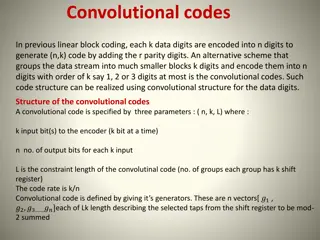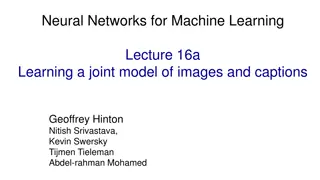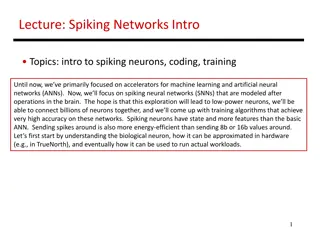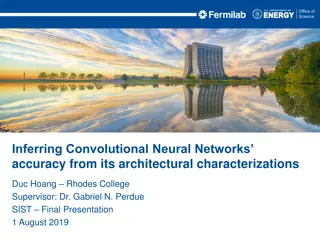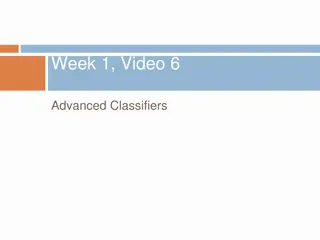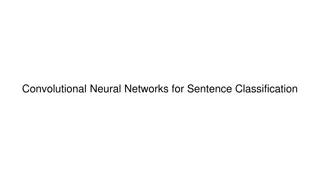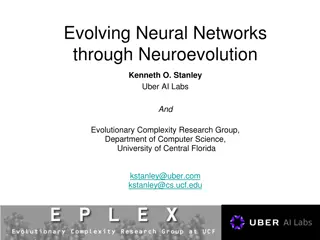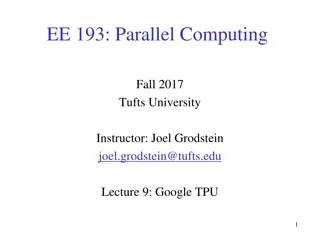Convolutional Neural Networks for Sentence Classification: A Deep Learning Approach
Deep learning models, originally designed for computer vision, have shown remarkable success in various Natural Language Processing (NLP) tasks. This paper presents a simple Convolutional Neural Network (CNN) architecture for sentence classification, utilizing word vectors from an unsupervised neural language model. The model involves convolution operations, feature generation, and max-pooling, with regularization techniques like dropout for improved generalization. The objective is to leverage CNNs for effective sentence modeling and achieve state-of-the-art results in NLP domains. (Word count: 82)
Download Presentation

Please find below an Image/Link to download the presentation.
The content on the website is provided AS IS for your information and personal use only. It may not be sold, licensed, or shared on other websites without obtaining consent from the author.If you encounter any issues during the download, it is possible that the publisher has removed the file from their server.
You are allowed to download the files provided on this website for personal or commercial use, subject to the condition that they are used lawfully. All files are the property of their respective owners.
The content on the website is provided AS IS for your information and personal use only. It may not be sold, licensed, or shared on other websites without obtaining consent from the author.
E N D
Presentation Transcript
Convolutional Neural Networks for sentence classification Paper presentation by: Aradhya Chouhan
Author Yoon Kim : New York University
introduction Deep learning models have achieved remarkable results in computer vision (Krizhevsky et al., 2012) and speech recognition (Graves et al., 2013) in recent years Originally invented for computer vision, CNN models have subsequently been shown to be effective for NLP and have achieved excellent results in semantic parsing (Yih et al., 2014), search query retrieval (Shen et al., 2014), sentence modeling (Kalchbrenner et al., 2014), and other traditional NLP tasks (Collobert et al., 2011).
objective In the present work, we train a simple CNN with one layer of convolution on top of word vectors obtained from an unsupervised neural language model.
Model: data representation Let xi R k be the k-dimensional word vector corresponding to the i-th word in the sentence. A sentence of length n (padded where necessary) is represented as x1:n = x1 x2 . . . xn, (1) where is the concatenation operator. In general, let xi:i+j refer to the concatenation of words xi , xi+1, . . . , xi+j . A convolution operation involves a filter w R dim hk.
Model: convolution A feature ci is generated from a window of words xi:i+h 1 by ci = f(w xi:i+h 1 + b). (2) Here b R is a bias term and f is a nonlinear function such as the hyperbolic tangent. This filter is applied to each possible window of words in the sentence {x1:h, x2:h+1, . . . , xn h+1:n} to produce a feature map c = [c1, c2, . . . , cn h+1], (3) with c R dim n h+1.
Model: max pooling We then apply a max-overtime pooling operation (Collobert et al., 2011) over the feature map and take the maximum value c = max{c} as the feature corresponding to this particular filter.
Regularization: dropout For regularization we employ dropout on the penultimate layer with a constraint on l2-norms of the weight vectors (Hinton et al., 2012). Dropout prevents co-adaptation of hidden units by randomly dropping out i.e., setting to zero a proportion p of the hidden units during forward-backpropagation.
Regularization: dropout Given the penultimate layer z = [ c1, . . . , c m] (note that here we have m filters), instead of using y = w z + b (4) for output unit y in forward propagation, dropout uses y = w (z r) + b, (5) where is the element-wise multiplication operator and r R m is a masking vector of Bernoulli random variables with probability p of being 1.
Hyperparameters Final values used in the Convolutional network
Datasets for testing the model MR: Movie reviews with one sentence per review. SST-1: Stanford Sentiment Treebank. SST-2: Same as SST-1 but with neutral reviews removed. Subj: Subjectivity dataset. TREC: TREC question dataset task. CR: Customer reviews of various products.
Results These results suggest that the pretrained vectors are good, universal feature extractors and can be utilized across datasets. Fine tuning the pre-trained vectors for each task gives still further improvements (CNN-non-static).
conclusion The present work has described a series of experiments with convolutional neural networks built on top of word2vec. Despite little tuning of hyperparameters, a simple CNN with one layer of convolution performs remarkably well. Our results add to the well-established evidence that unsupervised pre-training of word vectors is an important ingredient in deep learning for NLP.








